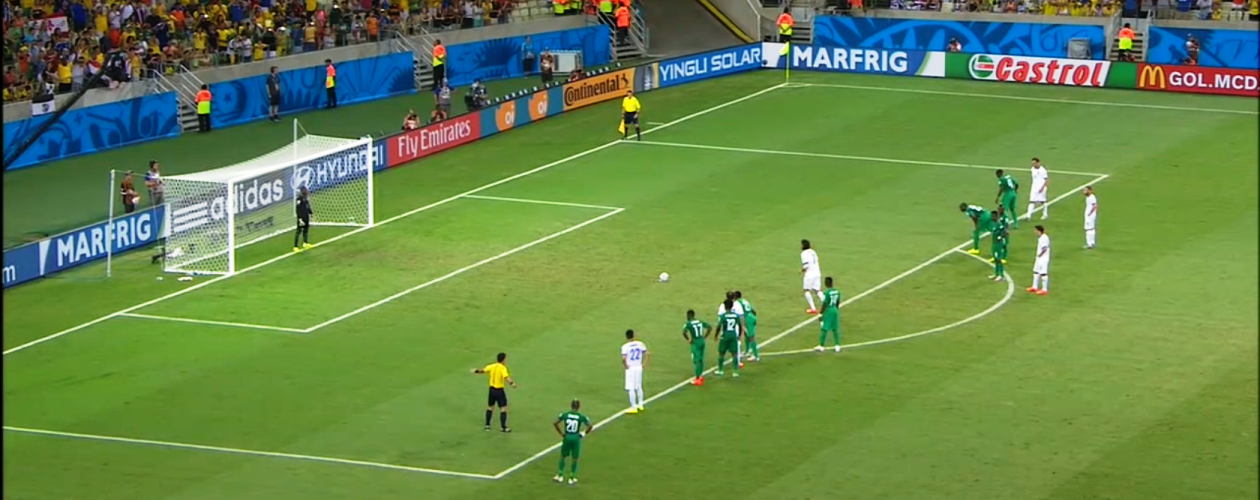The image below shows Samaras as he starts his motion toward the ball. Ivory Coast goal keeper Boubacar Barry is waiting at the center of the goal. Click on the image for a larger view.
It will take Samaras about 1.46 seconds to reach the ball from the image you see above. Barry, like all goal keepers, will have to rely on scouting reports, Samaras's body language, and a good bit of luck if he is to block the kick. After nearly 0.46 seconds, Barry is seen in the video initiating his lean to his left (right for Samaras). After another 0.58 seconds, Barry is clearly moving toward his left, either guessing the direction of the kick or seeing something in Samaras's body language, such as an open hip. Almost 0.42 seconds after that, Samaras kicks the ball. The image below shows Samaras's right boot just making contact with the ball (click on the image for a larger view).
You can clearly see that just as boot meets ball, Barry has committed to blocking a shot he believes will be down and left of him. Notice how low to the pitch he is before the ball has even left Samaras's boot! He has also moved forward so as to reduce the projected area of the goal as seen by the ball at the kick point. The image below shows another view of Barry just before the kick (click on the image for a larger view).
You can once again see how committed Barry is to blocking down and to his left (down and to Samaras's right). The ball took only 0.375 seconds to reach the goal plane, so don't blame goal keepers for committing to a guess just as the ball is kicked. The goal area is (24 feet) x (8 feet) = 192 square feet (17.8 square meters). Throughout the 0.375 seconds the ball took to reach the goal plane, Barry probably blocked a total of around 9% of the projected area, though that percentage drops to no more than 5% or so once the ball reaches Barry.
Barry just missed getting the block! Check out the image below (click on the image for a larger view).
Greece's ticket to the knockout stage is mere inches from Barry's fingers. The next image shows that the cropped video I took can't distinguish Barry's glove from the ball (click on the image for a larger view).
The final image I show below is a closer look from the back of the goal (click on the image for a larger view).
Look how close that ball is to being blocked! That is the difference between moving on to the knockout stage (Greece) and heading home (Ivory Coast). There is no way Ivory Coast wanted anyone else defending that kick. It is interesting to note, though, that Barry is listed at 5 feet 10 inches (1.80 meters) tall. The backup goal keeper for Ivory Coast, Mandé Sayouba, is listed at 6 feet 3 inches (1.93 meters) tall. Ivory Coast had already made three substitutions when the decisive penalty kick was taken.
Of course I had to model the trajectory of the ball. The image below shows the three-dimensional trajectory with the goal plane shown as a rectangle (click on the image for a larger view).
I show the trajectory shadow on the pitch, plus the no-spin trajectory and shadow. The ball had slight counterclockwise spin (as seen from above), and thus curved very slightly toward Barry. Brazuca was launched 7 degrees off the pitch at 71.0 mph (114 kph). The ball had only slowed to 63.1 mph (101.5 kph) when it passed the goal plane. At that launch speed, the drag force on the ball is the same as the ball's weight!
Congratulations to Greece for making the knockout stage!








No comments:
Post a Comment